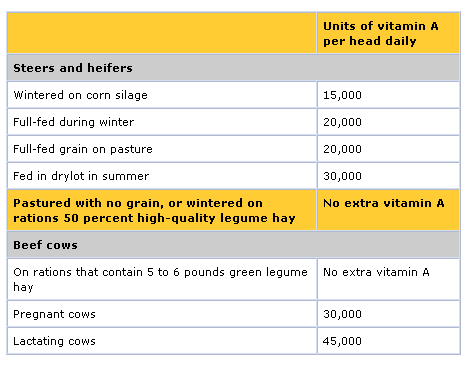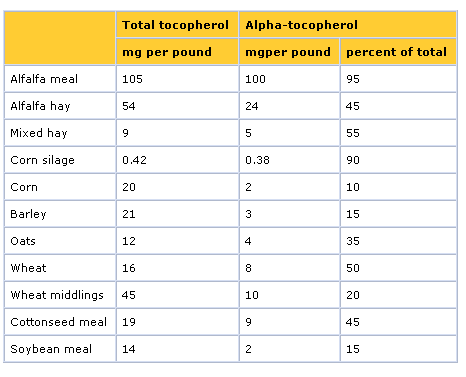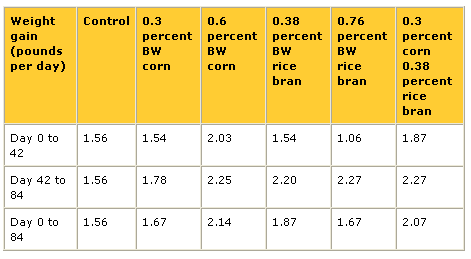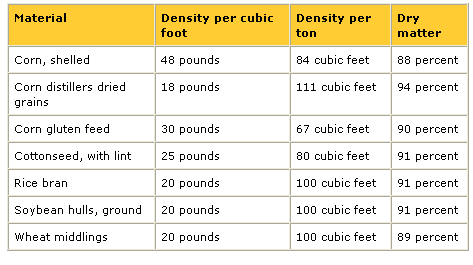



Alternative Feeds for Beef Cows and Stockers
By David L. Lalman Department of Animal Sciences, University of Missouri Extension - Harvested and purchased feeds make up nearly 40 percent of annual production costs in typical cow/calf operations.These costs also have a dramatic impact on cost per unit of gain in stocker operations. Consequently, cattle producers must continually evaluate new methods to make efficient use of available resources while optimizing animal performance and minimizing supplementation costs. Often, when cattle graze marginal to low quality forages, supplemental protein or energy is required to enhance either forage use or animal performance. Depending on the cost of more traditional feedstuffs, alternative feeds often provide an opportunity to reduce the cost of supplementation while maintaining or improving animal performance. This guide provides cow/calf and stocker operators with information on nutrition and other considerations for the use of several alternative feeds available in the Midwest.
Supplementation basics
ProteinCrude protein values for byproduct feeds discussed are included in Table 1. However, protein supplements should also be evaluated based on the type of protein provided. Ruminants use protein from feeds and forages in two ways:
- The dietary protein is broken down in the rumen to volatile fatty acids and ammonia. The ammonia is incorporated into the rumen microbial population as microbial protein. Rumen microbes are then flushed out of the rumen into the small intestine, where the microbes are broken down themselves and the resulting protein is absorbed and used by the host animal. Protein sources that are degraded in the rumen and used in this manner are referred to as degradable intake protein (DIP). Examples of protein sources with high DIP values include soybean meal, legume hay, cottonseed meal, corn gluten feed and wheat middlings.
- Some dietary protein escapes degradation in the rumen and is flushed into the small intestine. Here, digestive enzymes break down the dietary protein and the resulting proteins and amino acids are absorbed and used by the host animal. This type of protein is usually referred to as undegradable intake protein (UIP), because it is not digested by rumen microbes. Examples of feeds high in UIP include blood meal, corn gluten meal, feather meal and distillers dried grains. Additionally, some protein is totally indigestible or unavailable to the animal.
Table 1
Typical nutrient composition of corn grain and selected byproduct feeds

Note
Nutrient composition from National Research Council (1984) and other current research literature. All nutrient values are based on 100 percent dry matter.
1NDF = neutral detergent fiber; Ash = total mineral content; TDN = total digestible nutrients; NEm = net energy for maintenance; NEg = net energy for gain; CGF = corn gluten feed; SH = soybean hulls; WM = wheat middlings; RB = rice bran; WCS = whole cotton seed; DDGS = distillers dried grains with solubles
Energy
Table 1 shows energy values for the byproducts discussed in this guide. These energy values are averages based on data from the National Research Council and other sources. Unfortunately, energy values for many feeds change as the amount in the diet changes. This is especially true when replacing forage or roughage with concentrate. These changes in energy value are referred to as associative effects and can be positive or negative. Energy from grain is primarily in the form of starch or nonstructural carbohydrate. The majority of forage energy is in the form of fiber, or structural carbohydrate. When a small amount of starch-based energy supplement is fed (0.25 percent of body weight or less), forage intake and digestibility are either not affected or slightly improved. However, when grain is supplemented at a higher level, forage intake and digestibility generally decline. The impact of this negative associative effect is relative to the amount of grain fed as well as the type and quality of the forage. The calculated energy value of the diet may meet or exceed the animal's requirement. However, in reality, adding grain beyond a threshold of about 0.5 percent of body weight, may be counterproductive if the goal is to maximize forage intake and digestibility. Also, diets high in starch have greater risk of producing digestive upset due to acidosis. Wheat middlings and rice bran are two byproducts that have considerable starch content.Several of the byproducts discussed below provide energy in the form of highly digestible fiber, or structural carbohydrate. Because the energy is in the same form as that in the forage, negative associative effects are not nearly as dramatic as those seen with starch-based supplements. Examples of byproducts that provide energy in the form of highly digestible fiber include corn gluten feed, dried distillers grains, soybean hulls and wheat middlings.
Minerals
Mineral nutrition is an important part of a comprehensive supplementation program. All the byproducts discussed, except for soybean hulls, are relatively high in phosphorus. Beef cattle diets should be balanced to provide a calcium-to-phosphorus ratio of between 1 and 2 parts calcium to each part phosphorus. In some cases a calcium source may need to be added to the supplement or mineral mix to achieve this ratio. Many of these byproducts are also good sources of potassium. In many cases, depending on the level of byproduct in the diet, a lower-cost mineral supplementation program can be adopted because of the minerals provided in the byproduct.Corn gluten feed
Corn gluten feed is a product of the corn wet milling industry, which produces high-fructose corn syrup. A kernel of corn has five primary constituents: starch, gluten, hull, water and germ. Corn gluten feed is that portion of the kernel that remains after extraction of starch, gluten and germ. The major component in corn gluten feed is the hull, or bran; therefore; it is relatively high in fiber (Table 1). Corn gluten feed is available in wet (60 to 65 percent dry matter) and dry form (89 to 90 percent dry matter). The dry form is usually marketed as pellets, although some mills sell it in meal form.Corn gluten feed is high in protein (22 to 28 percent). Most of this protein is degradable in the rumen (65 to 80 percent).
When corn gluten feed is included in a forage diet at 0.5 percent of body weight or less, the energy value is equivalent to or greater than that of corn grain. The energy value of corn gluten feed relative to that of corn grain decreases as silage content of the diet decreases. Conversely, in high-concentrate diets, corn gluten feed has 85 to 95 percent of the energy value of corn grain.
Dried distillers grains
Dried distillers grains are byproducts of the distilling industry, in which grains are fermented to produce alcohol. The spent grains are dried and sold as feedstuffs primarily used in ruminant diets. Solubles left over from fermentation are usually added to the grains before drying, resulting in a product called distillers dried grains with solubles (DDGS). Distillers grains are identified by the type of grain from which they are made, for example, corn or milo distillers.Distillers grains contain 25 to 30 percent crude protein and 8 to 12 percent fat (Table 1). The drying process decreases protein degradability (increases UIP). The degradable protein fraction typically ranges between 26 and 84 percent, with an average of 44 percent. This variation is due to a range of temperatures the feed is subjected to as it dries. Most analytical laboratories report acid detergent insoluble nitrogen (ADIN), which is commonly used as an "index" to estimate heat-damaged protein in forages. Recent research with nonforage proteins shows that ADIN is not a good indicator of protein digestibility or energy value but is a reasonably good indicator of undegradable intake protein.
Because of the higher protein content of DDGS, and resulting higher price relative to other energy sources, DDGS is generally considered a protein source. However, when economically feasible, DDGS is an excellent source of energy and in many situations should be comparable to corn gluten feed.
Soybean hulls
During processing soybeans are rolled or cracked to break the whole bean into smaller pieces so that the hulls can be removed. Soybean hulls are separated from the cracked seeds by an air stream, and the seeds are extracted with hexane to remove oil, leaving high-protein bean meal (48 percent). Next, the hulls pass to a toaster to destroy the urease activity. Finally, the hulls are ground to the desired particle size and stored to be added back to the 44 percent bean meal or shipped as soybean hulls. Grinding the hulls decreases particle size and increases density for mixing and shipping purposes.The concentration of crude protein in soybean hulls ranges from 10 to 16 percent (Table 1). They are an excellent energy source in the form of highly digestible fiber. Depending on the processing plant, soybean hulls are often available in both meal and pelleted forms.
As with other highly digestible fiber byproducts, the energy value of soybean hulls depends on the amount fed and the type of diet (concentrate versus forage or roughage). In a recent two-year study (Crawford and Garner, 1993), steers were fed fescue hay and received 0.7 percent of their body weight in corn, wheat middlings or soybean hulls (Table 2).
Table 2
Performance of steers receiving fescue hay supplemented with corn, soybean hulls or wheat middlings

1Fescue hay valued at $45 per ton; corn, soybean hulls and wheat middlings valued at $80 per ton. Adapted from Crawford and Garner (1993, p. 185).
Feeding this ration of byproduct feeds reduced hay intake an average of 13 percent with no difference due to supplement type. Hay digestibility was not measured, although cattle receiving rations supplemented with soybean hulls and wheat middlings showed higher average daily gains. This indicates greater use of the hay, supplement or both when cattle were supplemented with soybean hulls or wheat middlings than with corn.
Another series of studies conducted with 400- to 500-pound cattle grazing bromegrass or cornstalks showed that daily gain was equivalent when cattle were supplemented with 3 pounds per day of soybean hulls or ground corn. These results indicate soybean hulls have equivalent or slightly greater energy value than corn when fed as a supplement to forage diets at 0.5 percent of body weight or less.
However, when higher levels of soybean hulls are supplemented, energy value is reduced. When soyhulls were fed alone, 61 percent of soybean hull dry matter was digested, compared with 83 percent of soybean hull dry matter being digested when two parts soybean hulls were fed with one part hay. This reduction in soybean hull digestibility is caused by faster passage rate of small particles when little or no long-stem forage is included in the diet. The forage serves to slow passage and ruminal retention time, thereby increasing digestibility of soybean hulls.
Like other high-fiber byproducts, soybean hulls have lower energy value than corn grain when fed at a level greater than 20 percent of diet dry matter in high-concentrate diets.
Wheat middlings
Wheat middlings are one of several byproducts resulting from the flour milling process. Other products include wheat bran, wheat germ meal, wheat mill run, wheat shorts and wheat red dog. Wheat middlings and wheat mill run are often used interchangeably in the industry because their official definitions are nearly identical.This co-product has been used for many years in ruminant diets and is often incorporated into commercial supplements (as are many of the other byproducts) as a protein and energy source. Wheat middlings are a good source of protein ranging from 16 to 19 percent (Table 1). The energy available in middlings is in the form of both starch and highly digestible fiber. Starch content varies between 25 and 36 percent of wheat middling dry matter. Because of this variation, the nutrient value of wheat middlings may vary more than that of other byproducts in a given feeding situation.
Rice bran
Rice bran results from the physical abrasion and separation of the hull from rice grain, which is used for human consumption. Rice bran is produced when the hull and fragments of the hull are blended with some of the germ. It contains more fat than most other byproducts (12 to 16 percent), which makes it more susceptible to rancidity during summer storage. Rice bran is finely ground and has a powdery texture, making handling and storage in bins difficult due to stacking and bridging. Blending with other concentrates, such as grain, improves flow characteristics.Small particle size, starch and fat content all add to the risk of digestive upset and the potential for nutritional imbalances. In general, beef cattle diets should not exceed 6 percent fat on a dry matter basis.
Recent research on rice bran as a feed supplement for grazing steers (Table 3) and cows on hay diets indicates that when rice bran is supplemented at 0.4 percent of body weight, it has approximately the same energy value as corn grain fed at the same level. However, when rice bran is supplemented at 0.76 percent of body weight, the energy value was less than that of corn fed at 0.6 percent of body weight.
Table 3
Weight gain of steers fall grazing fescue/clover pastures and supplemented with corn or rice bran

Adapted from Forster et al. (1993).
Whole cotton seed
Whole cotton seed can be purchased from cotton gins either before or after the "lint" has been removed. Most of the whole cotton seed used by the beef industry has not been de-linted. This cotton ginning byproduct has the unique distinction of being high in energy, fat, protein and fiber (Table 1) as well as being relatively palatable to cattle. Seldom are all these nutritional characteristics found in one feed.Because of the high fat content (20 percent), cattle should not consume more than 0.75 percent of body weight. Most situations would not require supplementation at more than 0.5 percent of body weight to correct protein or energy deficiencies in a forage diet. Diets exceeding 6 percent fat on a dry matter basis can reduce forage digestibility, which ultimately reduces the value of the supplement.
The quality of cotton seed varies; it should be clean, free of foreign debris, and white to whitish-gray in color. Good-quality cotton seed should rattle when it is shaken. Storing cotton seed that is too wet at harvest may result in heating or molding, as evidenced in a dark or black seed. Heating can damage the protein and may cause lypolysis (breakdown of fat into fatty acids), both of which may lower quality.
A disadvantage of whole cotton seed is its physical characteristics. Because it is bulky and does not flow in mechanical systems, it must be handled with a front-end loader or manually with a shovel.
Additional considerations
Byproducts vary in bulk density and physical characteristics (Table 4). Therefore storage and handling must be considered. The meal forms are dusty and tend to bridge in self-feeders and grain bins. Pelleting greatly reduces these problems but costs from $8 to $15 per ton extra. Pelleting also increases the bulk density to approximately the same as that of corn, thereby reducing transportation cost.Table 4
Bulk density of selected byproduct feeds

Adapted from Kammel (1991, pp. 113-114).
Sources and costs
Byproduct feeds vary substantially in price throughout the year and tend to be seasonal in availability. Cattle producers must continually monitor supplemental needs and feed prices to take advantage of the opportunity to use alternative feed sources to reduce the cost of production. This requires planning, not only to have storage available, but also to know how to incorporate the alternative feed into an existing feeding system.To assist beef and dairy producers in locating byproduct feeds and monitoring prices, a By-product Feed Price Listing has been published since 1987 by the University of Missouri. This weekly bulletin lists companies, phone numbers, addresses, contact persons, feeds, current prices and other purchasing information. The bulletin is available without charge through the Agriculture Electronic Bulletin Board.
January 2006



